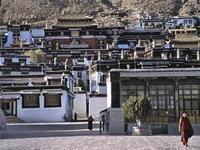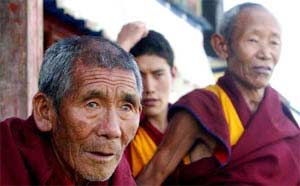Tushilumpo Monastery - A marvelous architecture of Tibet
Dawn is the best time to see Tushilumpo monastery. The light is tilted through the tile roofs that stand out in the middle of the black shadow of Thuong Tich mountain, augmenting the mysteriousness of the monastery located in the ancient city of Xigaze, the ancient capital of Tibet and now the city. the second largest in Tibet after Lhasa.
 Built in 1447, through centuries of development, the monastery now covers an area of 18.5 hectares with more than 50 sophisticated carved lecture halls, with 3600 rooms for lamas.
Built in 1447, through centuries of development, the monastery now covers an area of 18.5 hectares with more than 50 sophisticated carved lecture halls, with 3600 rooms for lamas.
The living Buddha Chiazha Qamba Chili said the monastery used to have 3800 lamas but now only 780. The 52-year-old abbot is the embodiment of the living Buddha from the age of 7. The Buddha lived is the highest rank that a lama can achieve. When a high moral lama is dead, it is believed that he will reincarnate into another child.
Chiazha lived in a house with two brick chambers with wooden pillars that could withstand the second floor with polished clay. Despite growing up from the monastery, Chiazha still uses modern aspects: the Flying Fish typewriter uses Tibetan letters, tie cravats and vests.
He was a devout lama in religious duties and ran the Tushilumpo monastery. Chiazha's greatest responsibility now is to find the incarnate child of the 10th Panchen who passed away because of heart disease in 1989.
780 The lamas in the monastery aged 17 to 87 are strongly selected through examinations from all over Tibet, Inner Mongolia and Yunnan, Guizhou, Shandong provinces . of China. Life in the monastery was very harsh, the lamas got up at 6 am and gathered at the chapel to read the Sutra and eat breakfast.

The lamas are at the monastery
From 9:30 am to noon, they go to work or to class. After lunch and lunch break, they have to work or return to class. In the afternoon read Sutra and eat porridge from 6-8 pm. The food is very simple, the vegetarian food is tsanba and yak butter tea. Tsanba is wheat flour mixed with yak butter and salt. The lamas are not allowed to smoke and drink alcohol.
The annual income of the whole monastery is about 1.6 million Yuan (540,800 USD) of which 1 million yuan is produced by agricultural products, 100,000 by the Chinese government and 500,000 by religious services. On average, a lama earns 80 yuan / month. The tallest eldest was 160 yuan and the new one was 45 yuan.
The whole monastery is a labyrinth of dark rooms, narrow corridors and a pitch full of darkness. There are many Buddha statues in the chapels. In the northeast corner of the monastery is a wall of incense everywhere. The lamas stretched a giant silk throughout the Buddha-painted wall. Every day replace a picture from Past Buddha, Present Buddha and to the Buddha's Future.
The North West is a crimson building, inside is the largest bronze statue of Guan Yin in the planet, 26.2 meters high, weighing 115 tons. The statue is decorated with pearls, agate, coral, gold and silver. 110 most skilled workers in the country work in the year to sculpt the statue. On the statues hang the paintings over the centuries, redrawing the lives of Shakyamuni and Zongkaba (1358-1419) who founded the Tibetan Buddhist sect.
- Westminster Abbey - Resting place of British legends
- Discover the world's oldest Buddhist monastery
- Du spring Truc Lam Tay Thien Monastery
- The 500-year-old Zen master remains intact with teeth and hair in India
- Geghard Monastery and Azat Valley
- The mystery of ancient Roman masterpieces makes modern Europe
- The mystery of the Tuong Hung in Tibet
- The climate heats up, threatening railways to Tibet
- Architectural works in Novgorod
- Sanahin Monastery - World Cultural Heritage in Armenia
- Monastery of Saint Catherine
- Monastery of Saint - Gall (Switzerland)
 Norway built the world's tallest wooden tower
Norway built the world's tallest wooden tower Kremlin
Kremlin Ashurbanipal: The oldest royal library in the world
Ashurbanipal: The oldest royal library in the world Decoding the thousand-year construction of Qin Shihuang shocked the world
Decoding the thousand-year construction of Qin Shihuang shocked the world